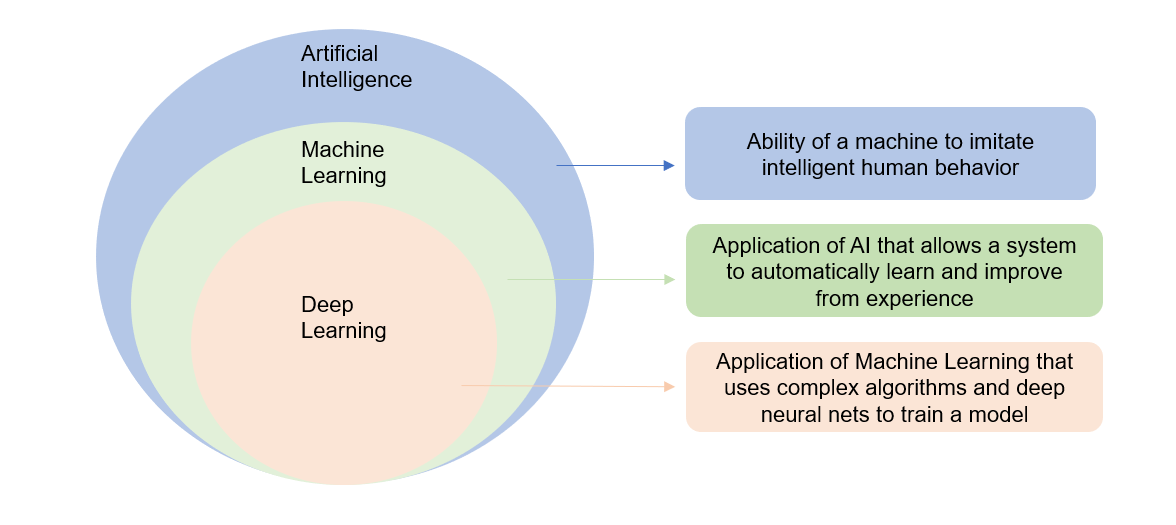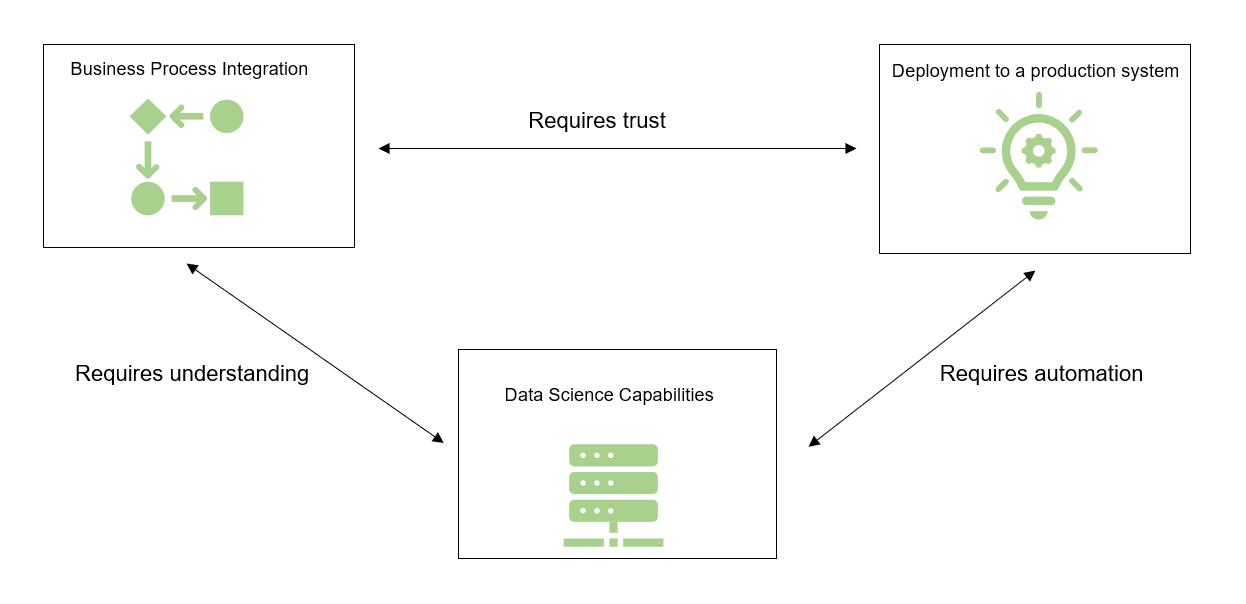From sci-fi realm to reality: How to successfully implement AI
“By far, the greatest danger of Artificial Intelligence is that people conclude too early that they understand it.” [1]
Artificial Intelligence (AI) is currently one of the hottest buzzwords in tech and with good reason. Previously solely in science fiction, the last few years have seen several innovations and advancements slowly transform into reality.
Still, while we hear about AI all the time, its meaning is not always straightforward nor is its implementation a given. Context and competencies are everything.
In this article, we give a high-level overview of the essential elements of AI to set the scene for answering this question: How can businesses own AI and implement it successfully, so it proves to be worth the investment?
Let’s dive in!
The matter of AI
Let’s start from the beginning, when did Artificial Intelligence start?
That was in 1955 when computer scientist John McCarthy coined the term ‘artificial intelligence’. He is also credited with developing the first AI programming language, Lisp.
What does Artificial Intelligence mean?
It’s a method of making a computer, a computer-controlled robot, or a software think intelligently like the human mind. It’s achieved by studying the patterns of the human brain and by analyzing the cognitive process. The outcome of these studies develops intelligent software and systems.
AI consists of a combination of Machine Learning techniques and so-called Deep Learning. The below graphic shows what they are about and how they are connected to the outcome of AI: [2]

To visualize the complex concept of the machine learning process better, the kitchen analogy clarifies:
- Gathering data (ingredients)
- Feeding it into an algorithm (kitchen appliance, e.g. an oven)
- Validating the model (recipe), and
- Using it to serve predictions (dishes).
So far for the analogy, since machine learning ‘appliances’ are a lot smarter than the average oven — they don’t just heat food, they learn how to prepare an entire dish! [3]
Why does AI matter for businesses?
This can seem like a no-brainer as after all, few people would say no to a dish that‘s prepared for them. Would you?
In fact, with humans and machines collaborating more closely, and AI innovations coming out of the research lab into the mainstream and in almost every business sector, the number of transformational types of ’dishes’ that can be prepared is dizzying.
Today, 37% of organizations have implemented AI in some form. While that still seems to be a low figure, the growth over the past four years of enterprises employing AI is represented by a much bigger percentage of 270%. [4]
Looking at the concrete motivation behind the AI employment, we see the following economic drivers:
- Productivity gains from businesses automating processes (including the use of robots and autonomous vehicles).
- Productivity gains from businesses augmenting their existing labor force with AI technologies (assisted and augmented intelligence like chatbots).
-
Increased consumer demand from the availability of personalized and/or higher-quality AI-enhanced products and services.
This demand resulting from the availability of personal assistants in our mobile phones, to the profiling, customization, and cyber protection that lies behind more and more of our commercial interactions, shows that AI touches almost every aspect of our lives.
The forecast is that by 2025, 95% of customer interactions will be powered by AI. And it’s just getting started.
When we look at the revenue side of things, global Gross Domestic Product (GDP) is expected to be up to 14% higher in 2030 as a result of the accelerating development and take-up of AI – the equivalent of an additional $15.7 trillion.
That’s more than the current output of China and India combined. Of this, $6.6 trillion is likely to come from increased productivity and $9.1 trillion is likely to come from consumption-side effects.[5]
Taking the AI cost into account
On the opposite side of revenue, we find cost which can be a challenge to achieving AI success.
Globally, companies are expected to spend an estimated $97.9 billion on AI in 2023.[6]
And while some of the world’s largest companies such as Amazon and Google’s parent company Alphabet thrive using AI, the majority of companies making AI investments do not report positive returns, however.
In a 2019 AI Global Executive Study and Research Report by MIT Sloan Management Review and Boston Consulting Group (BCG), 90% of the respondents agreed that AI represents a business opportunity for their company.[7]
That said, a growing number of leaders viewed AI as not just an opportunity but also a strategic risk: “What if competitors, particularly new entrants, figure out AI before we do?”
What’s more, many AI initiatives fail. 70% of the companies surveyed report minimal or no impact from AI so far. Among the 90% of companies that made some investment in AI, fewer than 40% reported business gains from AI in the preceding three years. This number improved to 60% when including companies that had made significant investments in AI.
Even so, this means that 40% of organizations making significant investments in AI have not reported business gains from AI.
Skills set for success in the AI training approach
To make the most of the opportunities offered to invest and achieve successful AI implementations in reality that lead to business gains, business and tech need to be aligned.
Before we look into what’s needed to get the right outcome from a business perspective, we will first look at what’s needed in the technical training approach to get the proper skill set for the machine learning process.
Programmers and researchers are adding many more skills to the list as we speak, but it comes down to getting fundamentally these three cognitive skills right as possessed by the human brain to one degree or another:
- Learning: The acquisition of information and the rules needed to use that information.
- Reasoning: Using the information rules to reach definite or approximate conclusions.
- Self-Correcting: The process of continually fine-tuning AI algorithms and ensuring that they offer the most accurate results they can.
Examples of some of the tasks performed by AI-trained devices include:
- Speech recognition
- Object detection
- Solve problems and learn from the given data
- Plan an approach for future tests to be done [8]
How to make AI a business success?
The key ingredients required for the successful integration of machine learning in corporate processes — ultimately leading to business success — are:
- Strong machine learning capabilities
- Fast and reliable deployment of machine learning solutions
- Seamless integration of machine learning solutions in the business process
The below graphic clearly shows how these three pillars depend on each other and are fundamental to the integration's success. [9]

We will deep-dive into the element of integrating machine learning into the business processes as it’s an essential starting point of an AI project.
Machine learning can generally improve business processes in two ways:
- Improving the quality of complex decision-making: Activities in trading based on algorithms and those in maintenance based on predictions are examples of complex decisions that can be improved by training machine learning models on massive amounts of data.
- Automating a decision-making process at scale: While an expert employee might make better decisions, a machine learning model can scale to making billions of these decisions at sub-second processing times. Common examples of this type of business case are:
- Recommender systems to personalize websites,
- Natural language processing to analyze live feedback from customers.
In business: Switching on AI
Integration in a business process is truly possible once the machine learning model is available on a production system — away from any test environment. This putting-in-production is also known as deployment. A successful deployment process is fast, reliable, and predictable. In the perfect world, your organization is capable of continuously improving and deploying machine learning models.
Several factors are fundamental to activating the business integration successfully and smoothly into production. Here’s what they are about and why you should keep a close eye on them:
- Trust
A slow deployment process can be a deal breaker as it hinders user acceptance and decreases trust in the application. This can be disastrous because trust is one of the critical factors of a successful business integration.
- Model value
An additional risk that most machine learning applications have: they show decay over time. The world is changing continuously, including the relationship between the input and the output of the models. This means the value of a model decreases with time. The more volatile the changes, the stronger this effect will be. This concept is commonly referred to as drift.
- High organizational maturity, standardization, and automation
A slow deployment process directly hurts the business value of a solution when drift occurs. The remedy seems obvious: frequently retrain the model with new data. Unfortunately, in practice this is difficult. Architecting a continuous integration and delivery process for machine learning requires a high level of maturity in organizations and a large degree of standardization and automation.
- Human labor, involving software engineers and IT operations
It happens frequently that the required amount of automation for continuous delivery in the machine learning domain is not achieved. Often this then becomes the responsibility of the people involved in building the machine learning models. While there is no lack of intelligence or creativity there, most of the work in getting to this high level of automation involves software engineering and IT operations which is far from the core competencies of data scientists. The result is often a codebase full of stitched-together scripts that are difficult to maintain and hand over.
All in all, automation requires expertise in the business domain, software development, business leadership, and machine-learning solid knowledge. Making an impact using machine learning requires gathering a team with the right mix of skills. After all, in the end, it’s the people who integrate machine learning solutions into the business.
Outlook: What does the AI future hold for businesses?
With AI as buzzwords and machines buzzing while they are learning their skills for all sorts of applications, the reality shows that while some companies have figured out how to be successful, most companies have a hard time generating value with AI.
As a result, many executives find themselves facing a set of AI realities: AI is a source of untapped opportunity, it is an existential risk, and it is difficult. Above all, it’s an urgent issue to address.
For businesses to benefit from AI and to report gains, the proper integration of the AI solution within the business operations is key. It’s not one software program to be installed on a PC to help out with one task, it’s about deploying AI via several learning techniques to assist, augment, or automate human decision-making.
These machines rely very much on human labor to get skilled for solutions in the first place and also have human staff responsible for integrating the AI solution into the business operations. Making an impact using machine learning requires gathering a team with the right mix of skills.
The key is alignment, within the organization and the AI programming. As a consequence, measuring the performance of the AI solution and the improvement it brings to the business process is crucial. This can be done by anticipating the preferred end situation and by investing time, money, and resources in the solution to get there as soon as possible and this exercise has to be structural and continuous for impact on the longer term.
And while some markets, sectors, and individual businesses are more advanced than others, AI is still at a very early stage of development overall. From a macroeconomic point of view, there are therefore opportunities for emerging markets to leapfrog more developed counterparts.
And like that, within your business sector, one of today’s start-ups or a business that hasn’t even been founded yet could be the market leader in ten years’ time.
Thanks for reading this blog post, we hope you enjoyed it! Did you know you can get all of our latest blog posts and more straight to your mailbox? Subscribe now to our newsletter to not miss out.
Banner photo by Tara Winstead on Pexels.com
[1] Quote from Eliezer Yudkowsky, co-founder of the Machine Intelligence Research Institute (MIRI), a non-profit organization dedicated to researching the development of safe and beneficial artificial intelligence
[2] Differences Between AI vs. Machine Learning vs. Deep Learning | Simplilearn
[3] AI is a buzzword. Here are the real words. | The Generator (medium.com)
[4] Top 18 Artificial Intelligence (AI) Applications in 2023 | Simplilearn
[5] Sizing the prize | pwc.com
[6] AI Alignment: A New Management Paradigm | MIT CISR
[7] Artificial Intelligence Global Executive Study and Research Report | 2019 Center for Information Systems Research Massachusetts Institute of Technology Sloan School of Management Review and Boston Consulting Group (BCG)
[8] What is Artificial Intelligence? Types, History, and Future | 2023 Edition Simplilearn
[9] The three key ingredients of successful AI | Cubonacci










